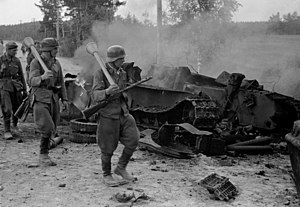Battle of Tali-Ihantala
| Battle of Tali-Ihantala | |||||||
|---|---|---|---|---|---|---|---|
| Part of the Continuation War | |||||||
 Finnish soldiers marching next to a destroyed Soviet T-34 tank |
|||||||
|
|||||||
| Belligerents | |||||||
|
|
|
||||||
| Commanders and leaders | |||||||
|
Karl Lennart Oesch Kurt Kuhlmey |
Leonid Govorov Dmitry Gusev Aleksandr Cherepanov |
||||||
| Strength | |||||||
| 50,000 | 150,000 Soviet sources: 148,000–160,000 |
||||||
| Casualties and losses | |||||||
|
1,100 killed 1,100 missing 6,300 wounded 8,500 total casualties |
Finnish estimate: 600 tanks 120–280 aircraft Later Finnish estimate: 21st Army: estimated 4,500–5,500 killed 13,500–14,500 wounded 23rd Army: 1,458 killed, 288 missing, 6,159 wounded 27,500 total casualties |
||||||
The Battle of Tali-Ihantala (June 25 to July 9, 1944) was part of the Finnish-Soviet Continuation War (1941–1944), which occurred during World War II. The battle was fought between Finnish forces—using war materiel provided by Germany—and Soviet forces. To date, it is the largest battle in the history of the Nordic countries.
The Finns, though outnumbered 3 to 1, inflicted more than three times the number of casualties on the Soviet forces than they received. However, with just 50,000 men to the Soviets 150,000, the Finnish forces took proportionally more casualties. It marked a point in the Soviet offensive when the Finnish forces first prevented the Soviets from making any significant gains. Earlier at Siiranmäki and Perkjärvi the Finns had halted advancing Soviet forces. The Finnish forces achieved a defensive victory against overwhelming odds.
After the Soviets had failed to create any breakthroughs at Tali-Ihantala, Vyborg Bay, or Vuosalmi, the Soviet Leningrad Front started the previously planned transfer of troops from the Karelian Isthmus to support Operation Bagration, where they were encountering particularly fierce resistance. Though the Leningrad Front failed to advance into Finland as ordered by the Stavka, some historians state that the offensive did eventually force Finland from the war.
After the initial Finnish advance of 1941, the Continuation War was stabilized to trench warfare with very little activity on either side. When the Siege of Leningrad was lifted in January 1944, the Stavka received orders to plan an offensive against Finland to push it out of the war.
The Soviet attack on the Finnish front commenced on the Karelian Isthmus on June 9, 1944, (coordinated with the Allied Invasion of Normandy). Three Soviet armies were pitted there against the Finns, among them several experienced Guard formations.
...
Wikipedia
